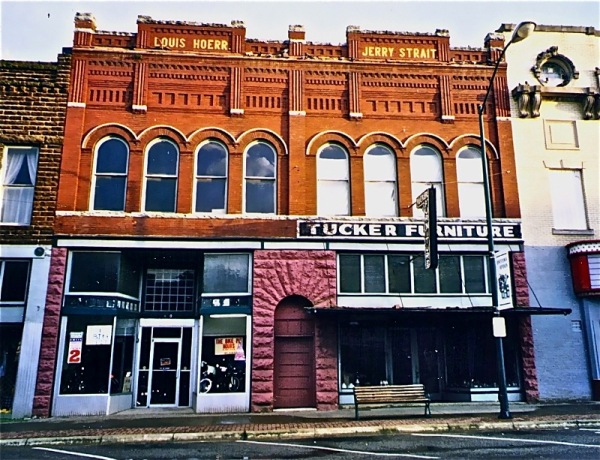
Roller Bowl 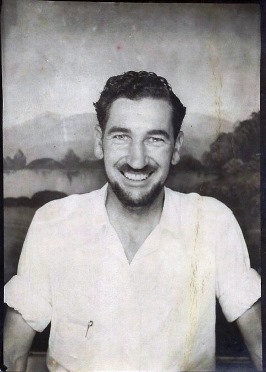
CURLEY O'DONNELL IS NEW PROPRIETOR OF BOWLING LANES
Denison Bowling alleys became known recently as "Curley O'Donnell Bowling Lanes" when Paul "Curley" O'Donnell, a resident of Denison for the past 3 years, announced his purchase of the establishment from George Griffith on December 20. Mr. O'Donnell, who for the past 13 years has worked with Ed Shroeder in 7-Up Bottling Co. came to Denison from Denton when Mr. Shroeder took over the management of the local plant. A native of Dallas, Mr. O'Donnell believes that with war conditions as they are bowling has become the chief source of entertainment for hundreds of Denison people who do not have facilities for traveling to larger cities. He wants Denison residents to know that he appreciates the continued patronage of all old customers of the alleys and invites others to participate in this sport which not only provides fun but is also a healthful exercise. 
"Remembering
the Roller Bowl"
written by Calvin Mauldin Denison Herald February 10, 1991 pages 2-4 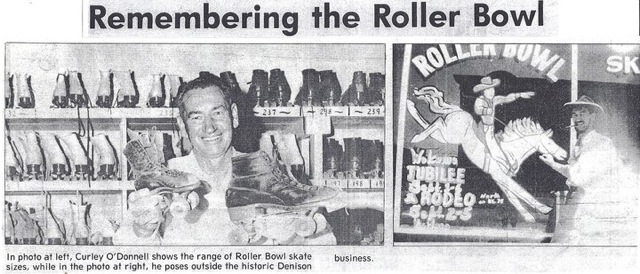
Inspiration, imagination, and financial risk can, in some instances, create an entity that will live on for generations as a pleasant and romantic memory. Such a special place came to be nearly 46 years ago, called the Roller Bowl.
That the Roller Bowl could be built at all is a miracle unto itself, considering the times. World War II was still raging in the Pacific during the summer of 1945 when Basil Georges, owner of the Tropical Gardens and Curley O'Donnell, operator of a 4-lane bowling alley at 411 W. Main became business partners. Both men believed that Denison needed a recreation center. Not just any garden variety recreation center with pinball machines, pool tables and a juke box. No, this would be a Texas-sized amusement place, of a type this area had never seen. The site chosen was the recently vacated 2-story structure at 131 W. Main, which had housed the U.S. Engineers. Despite tight rationing of building materials, a complete remodeling was begun in early June 1945. Starting with a budget of $30,000, that soon escalated to $48,000 before completion, nearly 50 men were put to work on the elaborate project. Over the course of the next 5 months, the outside of the building was stuccoed and painted cream and black. A new entrance was added to the southwest corner. Two red and green neon signs over the entrance glowed "Skating-Bowling," but the real eye catcher to the exterior was the 10-foot-tall pinball-shaped neon sign flashing "Roll or Bowl." The neon sign was the largest of its type in North Texas. The ground floor of the Roller Bowl was the bowling alley. The 8 lanes utilized the most up-to-date semi-automatic pinsetters available at the time. Covering the pin racks was an Art Deco carved wooden ceiling. To insure a perfectly smooth surface, "Mineral Lastic," instead of shellac, was applied to the maple/pine alleys. The interior was painted a pleasant, non-distracting cream and brown. For the bowlers' convenience, ultra-modern chromium scoring tables were placed at each lane, and for the spectators, 100 soft, brown leather chairs were mounted in rows with excellent visibility. Going up the 8' wide stairs, patrons were led to the box office of the skating rink, behind which stood the horseshoe shaped counter where skates could be picked up. The skating rink was painted in raspberry and buff. The giant windows had equally large venetian blinds that were covered with specially-made drapes. Nearly $4,000 was spent on the 6,000 square foot maple skating floor, with much of the expense required to make the surface as ripple-free as possible for the skater. Padded leather seats were provided for the spectators, and as a safety precaution, a 3' tall, padded guard rail separated the spectator area from the skate floor. Both levels had their own soda fountains and restrooms, with a spacious ladies' dressing room on the second floor. To keep the noise of the skates from being transmitted to the bowling alley below, thick velvet carpeting and sound-deadening material was laid into the air space between the floor and ceiling. As grand opening time neared, rationing was threatening to delay the event with unexpected shortages in of all things, bowling balls, bowling pins and shoe skates. Ingenuity and perseverance won out, remembers Curley O'Donnell. "At that time you were only allowed 3 sets of pins a year, 25 pair of new shoe skates, and new bowling balls were impossible to find. I had 200 balls from my old alley that were in good condition, but the pins (about 100) were pretty beat up so we bought an old wood lathe and began smoothing the pins with sandpaper while the lathe ran. This worked out pretty well. The pin was then dipped into a special paint called "pin live." We did this last process in a separate building because the paint was very volatile. That took care of the bowling problems, but skaters can't skate without skates. O'Donnell continues, "So much time has gone by, I don't remember what led to this, but I found out that Charlie Sherrard had 400 pairs of used, clamp-on skates with fiber wheels. The wheels wouldn't tear up the floor, but they sure would tear up a pair of shoes. That's why the clamp-ons rented for 35 cents and the shoe skates were 25 cents extra." Sherrard was noted for taking almost anything of value as a trade-in. Even a bear cub was used as a down payment in 1955. Roller Bowl debuted to the public on December 14, 1945. Nearly 1,200 people arrived for the 7 p.m. opening. First person on the skate floor was Kenneth Mills, a Denison businessman. Things heated up in the bowling alley when the Denison team challenged the Sherman team. The game lasted until midnight, with Sherman taking the victory, 2 to 1. Some of the Denison players were Pete Spears, Dick Clark, Joe Colona and Roy Nash. From that night on, bowling changed its image. As Curley recalls: "Before Roller Bowl opened, a bowling alley was not considered a proper place for a lady. Ours was a clean, upstanding facility operated under the rules and regulations of the American Bowling Congress. It wasn't long after we opened that more women began bowling, and later started their own league, with my wife, Maxine, on the team. Looking back, it makes me feel like a pioneer." The roller rink was managed by Dick and Margaret Sykes. Margaret was a professional skater and gold medalist who was on hand for exhibitions and skating lessons. The rink was also a member in the Roller Skating Rink Operators Association. In short, what this meant, was an enforced dress code. No T-shirts, shorts or blue jeans were allowed. Shirt tails had to be tucked in, and women were encouraged to wear a skating costume or slacks. Pretty high class to be sure, but necessary to build a reputation. Overnight, Roller Bowl became THE place to go. Hours could be spent there with the outside world forgotten. In one instance, that's exactly what happened to Henry Denton. "I had just been discharged from the Army," laughs Henry. "I had let my family know when I'd be coming in. The train pulled into the Katy Depot on schedule. Nobody was there to meet me, so I took a cab home. Nobody was there either. I got a ride back to the depot, thinking maybe they were running late. Still, not there. In the letters from home, I remembered hearing about this new amusement place that had just opened. Well, I walked up the street to look it over and once inside I saw the whole family there, bowling. They had gotten so caught up in the game, they forgot about me!" The giant amusement palace was a haven for young people. The atmosphere gave off such a romantic aura that we may never know how many couples took direct hits from Cupid's arrows by meeting there. One can only imagine. In this time period, hundreds of young men had just returned from the war and hundreds more were stationed at nearby Perrin Field. "Most of the young airmen would run out of money before they ran out of month," laughs Curley O'Donnell. "I would let them skate on credit. Usually they paid off the debt, but even if they didn't it was still good for business." Surprisingly, as successful as Roller Bowl was, Curley O'Donnell and the Sykes were constantly coming up with new ways to entertain. The skating rink hosted professional wrestling several times a month and twice a week after the nightly skating was over, hotly contested hockey games were played against teams from Durant, Sherman, Denton and Gainesville. The event that stands out, though, was the Roller Bowl Follies. "This was a local talent show featuring our skating students," said O'Donnell. "We'd originally planned a one-night show only, but we had so many entries we had to expand it to 2 nights in a row. "I can't recall who won, but I do remember John Hillerman and his sister did a dance routine on skates. In those days he was known as Jackie Ben, and he didn't have the funny accent." The business continued without any major changes until 1952, when Basil Georges wanted to sell out his interest. "Basil wanted to move up north and start a new business," said Curley. "He was what you would call a silent partner anyway. I bought him out and shortly thereafter sold the bowling alley part and kept the rink." By 1957, the bowling alley closed and was moved to a new location on Hwy. 75A South. Feeling the crunch from the overhead expenses and a lease that had expired, O'Donnell built a new facility at 207 W. Morgan, called "Curley's Skateland." During its 16 years of operation Skateland became THE place for the children and grandchildren of those original skaters who frequented the entertainment palace nearly 2 generations ago. In March 1983 Curley O'Donnell sold the Skateland property to Skaggs and retired. Though still very active in the Lions Club, Curley readily admits, "I still miss the amusement business." 
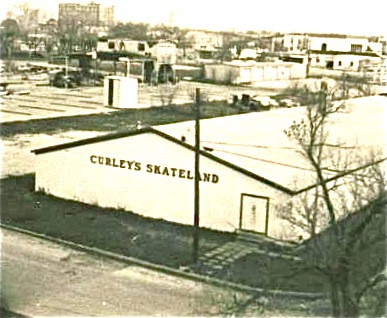
Curley's Skateland You can see the foundation to Skagg's in 1983 being built, and the last picture of Curley's Skateland, Albertson stands on Curley's today. In the background Hotel Denison and Interfirst Bank are visible. Courtesy of Billy Holcomb and Tina O'Donnell Yates 
Denison Herald
June 12, 1957 O 'Donnell Building Area's Largest Skating Rink Here With the return of fair weather, construction is making progress on the skating rink building being erected by Curley O'Donnell in the 200 block of W. Morgan. The 60'x140' building will be the first built here for exclusive skating rink use and will be the largest this side of Dallas. To be known as Curley's Skateland, the concrete block building will have 11,300 square feet of maple flooring without any center posts. The roof will be supported by steel trusses. O'Donnell has been in the skating rink business here since the opening of the Roller-Bowl a dozen years ago. He operated on the second floor of the building at the corner of Main and Austin until a couple months ago. He hopes to have his new establishment ready for operation in a couple of months. For almost a year he has owned a Sherman skating rink, on South Montgomery, which he will continue to operate. 
Denison Herald
January 23, 1956 New Roller Bowl Schedule Set As O'Donnell Buys Sherman Rink Denison's Roller Bowl Skating Rink will go on a new schedule this week, owner Curley O'Donnell has announced. O'Donnell has purchased the Sherman Roller Rink and this necessitated the new schedule. The local rink will be closed Wednesday and Thursday nights, and the Sherman Roller Rink will close Monday and Tuesday nights. Sessions will continue from 7:30 to 10 p.m. as usual on other nights. Both rinks will be available for private parties on the nights which they are closed, O'Donnell announced. Parties can also be scheduled any day at either rink. O'Donnell is closing the Sherman rink this week for major repairs including floor repair, sanding and rearrangement of the counters to make room for a lot more skates. "I plan to put more and better skates in the Sherman rink just as I have in Denison," O'Donnell said. Curley has been in the skating business for the past 11 years and knows how to operate a rink so everyone has fun while enjoying the best exercise possible. "Yes, skating is healthful, and I believe in providing plenty of good skates, and good floor and proper supervision in my rinks," commented O'Donnell. The Sherman rink was built in 1949, and O'Donnell has acquired both the business and building there. Addition of the new rink will not affect the operation of the Denison rink but instead will expand the skating sport in Texomaland through continuous improvements. 
Denison Herald February 10, 1991 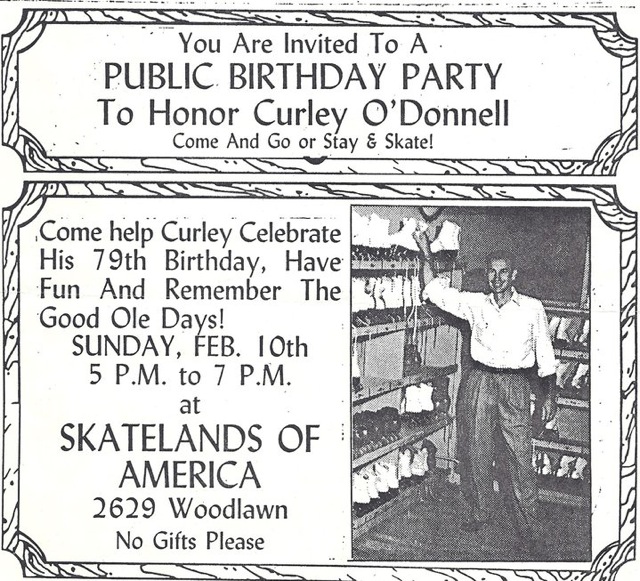
A.P. "Curley" O'Donnel died April 14, 1993 and is buried in Cedarlawn Cemetery, Denison, Texas. Courtesy of Tina O'Donnell Yates
Denison History Copyright © 2024, TXGenWeb. If you find any of Grayson County TXGenWeb links inoperable, please send me a message |
